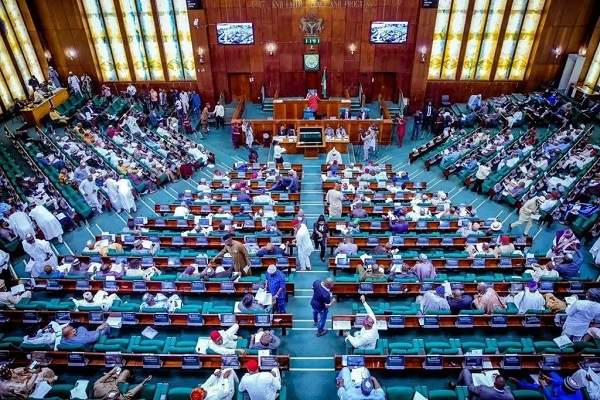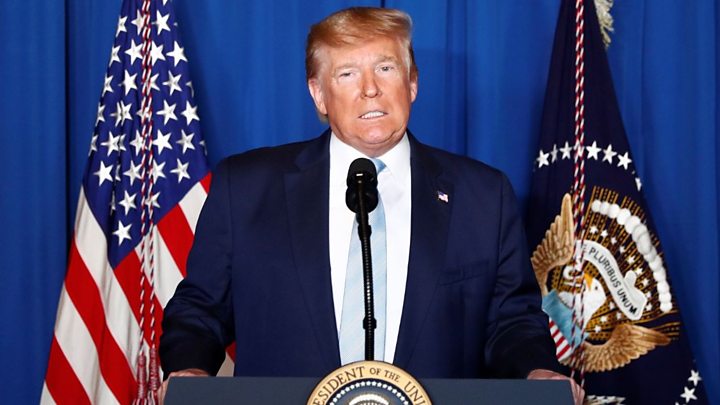- As After initial denial, Pentagon discovers it killed 10 allies in drone strike in Somalia
Donald Trump was accorded a chilly but deferential welcome at the White House on Thursday as the president-elect met with Barack Obama for a 90-minute private meeting in the Oval Office.
In the first stage of a 72-day transition process between Tuesday’s unexpected election victory and Trump’s inauguration on 20 January, Obama said the two men discussed “foreign and domestic policy” and how to ensure the handover of power went smoothly.
“I want to emphasise to you, Mr President-elect, that we now are going to do everything we can to help you succeed because if you succeed, then the country succeeds,” Obama told his successor during a brief photo opportunity afterwards.
A grinning Trump gave Obama a pat on the back as they got up to leave, and boasted to reporters of how long he had just spent in the Oval Office, though the president – more sombre-faced until then – jokingly advised him not to take any questions.
While they spoke, Trump’s wife Melania was shown around their new home in the official residence and East Wing by Michelle Obama, reportedly discussing what it was like to raise children in the White House.
Trump appeared to relish the welcome, though White House officials did not allow photographs of the traditional greeting outside. Obama appeared stiff and subdued throughout.
“This was a meeting that was going to last for maybe 10 or 15 minutes, and we were just going to get to know each other,” said Trump in the brief remarks to reporters he gave from an ornate armchair usually occupied by world leaders.
“We had never met each other. I have great respect. The meeting lasted for almost an hour and a half. And it could have – as far as I’m concerned, it could have gone on for a lot longer.”
Asked if he would seek advice from Obama in the future, despite intense criticism from both of them toward the other in the past, Trump described his political opponent as a “very good man”.
“We discussed a lot of different situations, some wonderful and some difficulties,” said the president-elect, according to the official White House transcript of their remarks. “I very much look forward to dealing with the president in the future, including counsel. He explained some of the difficulties, some of the high-flying assets and some of the really great things that have been achieved.”
Briefing reporters afterwards, press secretary Josh Earnest said he did not know what Trump had meant by “high-flying assets” and denied the Republican’s claim that only 10 minutes had originally been scheduled.
But he insisted the meeting was “a little less awkward than some might have expected” and tried to explain Obama’s comment that the meeting had been “excellent”.
“When you consider the profound differences between the two gentlemen and the fact they have never met before … I think that qualifies as ‘excellent’,” said Earnest.
Washington has quickly adopted a deferential approach toward the future commander-in-chief, despite widespread demonstrations in major US cities since Tuesday’s election and reports of an increase in racist attacks aimed at immigrants.
As votes from California and other Democratic-leaning states on the west coast were slowly processed on Thursday, Clinton was on track to exceed Trump’s share of the popular vote by 1.2%, fueling concern about the mandate for sweeping change.
Yet there were no protests visible outside the White House in the hour leading up to Trump’s arrival. One woman with a placard saying “stand up to racism” laid it on the ground as she was interviewed by a succession of media crews, though other protesters were expected during the meeting.
Instead, the traditional Marine guard stood stiffly outside the West Wing as Trump’s motorcade swept in from Ronald Reagan airport, where he left his trademark Boeing 757-200. The US Secret Service has announced a temporary no-fly zone for commercial aircraft over Trump Tower in New York, where the president-elect will continue to live for the next few weeks.
Trump’s motorcade arrived on the South Lawn at the White House, which is not visible to journalists or the public. He also refused to allow the usual presence of a pooled media representative with him as he travelled. Spokeswoman Hope Hicks said Trump would travel back to New York on Thursday night.
In a sharp change of tone, much of the US news media has treated Trump with the respectful approach usually granted to the US head of state when performing ceremonial duties, referring to the president-elect informally as PEOTUS.
During the Oval Office meeting, Ivanka Trump’s husband Jared Kushner – a likely top aide in the next administration – was escorted through the Rose Garden by White House chief of staff Denis McDonough.
Vice-president Joe Biden was due to meet with his successor, Mike Pence, while Trump headed to meet Republican congressional leaders Mitch McConnell and Paul Ryan on Capitol Hill. They have pledged to give him full support in repealing key Democratic legislation such as Obamacare and international climate change accords.
In the meantime, an American drone strike thought to have struck Islamist militants in Somalia actually killed 10 members of a regional force allied with the United States, according to results of a Pentagon investigation that have not yet been made public.
The September incident sheds light on the escalating involvement of U.S. forces in Somalia’s protracted war against al-Shabab, a group of al-Qaeda-linked militants. It also points to the unforeseen consequences of increased U.S. drone strikes in a country still run by clan militias.
“They’ve helped us out against a common enemy,” a U.S. military official said Thursday, referring to the regional forces who were killed in the strike. “If we had known who they were, we would have done everything we could to prevent it.” He spoke on the condition of anonymity because the investigation’s findings are not yet public.
As the United States has waded further into Somalia, it has struggled to form a coalition of allies from a range of rival groups. Two of those groups — from the states of Puntland and Galmadug — have targeted and arrested al-Shabab terrorists, and received American accolades for doing so.
But the groups also have been fighting one another for decades, mostly over territory in the city of Galkayo.
On Sept. 28, Puntland security forces were sent to investigate a “suspicious group,” thought to be al-Shabab based on American surveillance imagery, according to the U.S. official.
American forces accompanied the patrol as advisers, until they neared the unknown group. It was early in the morning, and visibility was limited when Puntland forces “started taking fire,” said the U.S. official. They asked for air support, and the U.S. military launched the drone strike.
Shortly after the attack, officials in Galmadug began accusing the United States of killing its own allies. They released images of government vehicles destroyed by the strike. There were protests in the streets. People burned American flags.
In interviews with The Washington Post in a hospital in Mogadishu, the Somali capital, two survivors of the strike who belonged to the Galmadug forces described the way it had hammered their unit.
“Small aircraft, sounding like flies, started hovering over us,” said one survivor, Ali Adan Mohamed. “At about six in the morning the airstrike started, the aircraft fired three missiles.
“I believed that the U.S. was neutral, but now it seems to me that they have sided with one of two clans,” he said.
When Galmadug state officials heard what happened, they were furious with the Americans.
“There is not any justification that could lead to such disaster,” Minister Osman Ise Nur, the head of Galmadug’s security operations, said in a phone interview. “We were amazed with what has happened to our forces despite the fact that they were fighting al-Shabab.”
The U.S. Africa Command issued a statement shortly after the attack that described the target of the strike as “a group of armed al-Shabaab fighters.”
But a new Pentagon report, parts of which were described to The Washington Post, contradicts that initial conclusion.
“We responded and struck the hostile force with the belief that it was al-Shabab,” the U.S. official said. “But we recognize that they were Galmadug forces.”
In other words, the United States appeared to have unwittingly entered into a war between two regional fighting forces, both its allies.
More than 75,000 people have been displaced by the fighting between Puntland and Galmadug forces in recent months, and are “in dire need of humanitarian assistance,” according to Abdelgadir Galal Ahmed, the Norwegian Refugee Council’s country director.
Somalia has been torn apart by civil war for 25 years, resulting in chaos that allowed the rise of al-Shabab in 2005. The White House considers the group one of its top concerns in sub-Saharan Africa, in part because its attacks extend beyond Somalia to civilian targets in neighboring Kenya, including the bloody strike on Nairobi’s upscale Westgate Mall in 2013.
The United States has a particularly strong relationship with the Puntland forces and has for years helped to train them.
Although the U.S. Africa Command investigation found that the drone strike had inadvertently killed Galmadug forces, it nonetheless ruled that the action was “legitimate” in that it probably saved the lives of the United States’ Puntland allies.
“The strike was clearly lawful,” the U.S. military official said.
Not long after the strike, Stephen M. Schwartz, the newly appointed U.S. ambassador to Somalia, met with Abdikarim Hussein Guled, the president of Galmadug, and other local officials. Galmadug officials said the ambassador apologized for the strike. The State Department would not confirm the apology.
Guardian with additional report from MSN


















